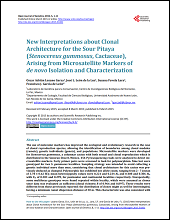| dc.creator | OSCAR ADRIAN LOZANO GARZA | |
| dc.creator | JOSE LUIS LEON DE LA LUZ | |
| dc.creator | SUSANA FAVELA LARA | |
| dc.creator | FRANCISCO JAVIER GARCIA DE LEON | |
| dc.date | 2015 | |
| dc.identifier | http://cibnor.repositorioinstitucional.mx/jspui/handle/1001/783 | |
| dc.identifier.uri | http://dspace.cibnor.mx:8080/handle/123456789/1531 | |
| dc.description | "The use of molecular markers has improved the ecological and evolutionary research in the case of clonal reproduction species, allowing the identification of boundaries among clonal modules (ramets), genetic individuals (genets), and populations. Microsatellite markers were developed for Stenocereus gummosus, a columnar cactus with both sexual and clonal reproduction which is distributed in the Sonoran Desert, Mexico. 454-Pyrosequencing reads were analyzed to detect microsatellite markers. Forty primer pairs were screened to look for polymorphism. Nine loci were genotyped for two S. gummosus localities. Sampling strategy was intended to avoid collecting a genetic individual more than once, considering that clonal architecture for this cactus was previously deduced as clumped. Polymorphic loci exhibited low allele count, ranging from 2 - 7 (mean of 3.78 ± 0.62 SE); mean heterozygosity values were 0.221 and 0.234 HO and 0.408 and 0.306 HE, with FIS of 0.383 and 0.299, for peninsular and continental localities respectively. Unexpectedly, some multilocus genotypes were found repeated within locality, which were assumed as clones since data was evaluated as sufficient (clonal richness R of 0.966 and 0.897). These results were different from those previously reported: the distribution of clones might as well be intermingled, having a minimum ramet dispersion distance of 30 m. This characteristic was also consistent with the recent colonization proposed for this and other arid lands plants. A wider genetic neighborhood, due to clone dispersion might affect diversity indexes while increasing the chance of geitonogamy and mating among relatives. The markers isolation and its population characterization allowed addressing new questions about S. gummosus ecology, clonal reproduction and reproductive biology." | |
| dc.format | application/pdf | |
| dc.language | eng | |
| dc.publisher | Scientific Research Publishing, Inc. | |
| dc.relation | info:eu-repo/semantics/reference/DOI/DOI: 10.4236/ojgen.2015.51001 | |
| dc.relation | info:eu-repo/semantics/reference/ISSN/ISSN: 2162-4461 | |
| dc.relation | info:eu-repo/semantics/reference/URL/URL: http://www.scirp.org/journal/ojgen | |
| dc.relation | citation:Lozano Garza, O.A., León de la Luz, J.L., Lara, S.F. and García de León, F.J. (2015) New Interpretations about Clonal Architecture for the Sour Pitaya (Stenocereus gummosus, Cactaceae), Arising from Microsatellite Markers of de novo Isolation and Characterization. Open Journal of Genetics, 5, 1-11. | |
| dc.rights | info:eu-repo/semantics/openAccess | |
| dc.rights | http://creativecommons.org/licenses/by-nc-nd/4.0 | |
| dc.source | Open Journal of Genetics | |
| dc.subject | info:eu-repo/classification/AUTOR/Cactaceae, Clonal Architecture, Microsatellites, Pyrosequencing, Stenocereus | |
| dc.subject | info:eu-repo/classification/cti/2 | |
| dc.subject | info:eu-repo/classification/cti/24 | |
| dc.subject | info:eu-repo/classification/cti/2417 | |
| dc.subject | info:eu-repo/classification/cti/241714 | |
| dc.title | New Interpretations about Clonal Architecture for the Sour Pitaya (Stenocereus gummosus, Cactaceae), Arising from Microsatellite Markers of de novo Isolation and Characterization | |
| dc.type | info:eu-repo/semantics/article | |
| dc.type | info:eu-repo/semantics/publishedVersion | |


